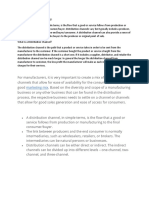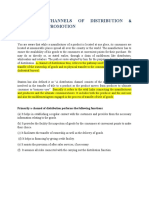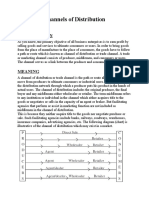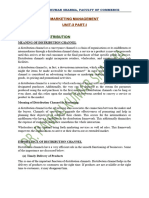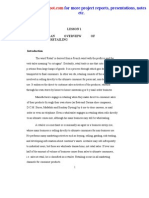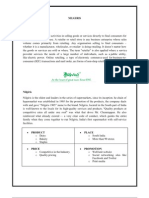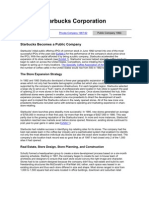0 ratings0% found this document useful (0 votes)
64 viewsChapter 3
International Islamic University Chittagong provides a course on supply chain management. The course discusses marketing channels and intermediaries. It defines channels as the network of participants that receive, handle, store, transport, and communicate products. It also discusses the types of channel partners like wholesalers and retailers. Wholesalers obtain large quantities of goods from producers and break them down into smaller units for retailers. They take ownership of the goods and assume the risks of loss or damage. The course emphasizes that channels must continually evolve to meet changing customer needs.
Uploaded by
samiulctg01Copyright
© © All Rights Reserved
Available Formats
Download as DOC, PDF, TXT or read online on Scribd
0 ratings0% found this document useful (0 votes)
64 viewsChapter 3
International Islamic University Chittagong provides a course on supply chain management. The course discusses marketing channels and intermediaries. It defines channels as the network of participants that receive, handle, store, transport, and communicate products. It also discusses the types of channel partners like wholesalers and retailers. Wholesalers obtain large quantities of goods from producers and break them down into smaller units for retailers. They take ownership of the goods and assume the risks of loss or damage. The course emphasizes that channels must continually evolve to meet changing customer needs.
Uploaded by
samiulctg01Copyright
© © All Rights Reserved
Available Formats
Download as DOC, PDF, TXT or read online on Scribd
You are on page 1/ 12
International Islamic University Chittagong
Department of Business Administration
Course Title: Supply Chain Management
Program BBA
Course Synopsis
(Objective of providing this Synopsis is to assist students in condensing out the fundamental object of the
topics detailed in the course plan. This is not a substitute to basic text book referred in the course plan
provided by the Department.)
Chapter 3: Marketng/Supply Channel
3.1 Channel:
Network of all participants in a supply chain engaged in the receiving, handling, storage,
transportation, and communications functions.
3.2 Channel management
The management of firms or individuals that participate in the flow of goods and services
from the raw material supplier and producer to the final user or customer.
A supply chain consists of upstream and downstream partners
Upstream: from the company is the set of firms that supply the raw materials,
components, parts, information, and expertise needed to create a product or services.
Down stream: arketing channels or Distri!ution channels. "uch as wholesalers and
#etailers
3.3 Levels of Channels:
$ompanies can design their distri!ution channels to make products and services availa!le
to customers in different ways. %ach layer of marketing intermediaries that performs
some work in !ringing the product and its ownership closer to the final !uyer is a channel
level.
0-Level: Direct arketing: A marketing channel that has no intermediary level.
That is direct from manufacturer to end users. &or example Dell.
1-Level: n!ire"t Marketing Channel: 'roducer(#etailer($onsumer.
2-Level: n!ire"t Marketing Channel: 'roducer()holesaler(#etailer($onsumer.
3-Level: n!ire"t Marketing Channel: 'roducer(Agent()holesaler(#etailer(
$onsumer
#. Consumer Marketing
3.$ mportan"e of Channels/nterme!iaries:
Today, marketing channel decisions are as important as the decisions companies make
a!out the features and prices of products.
*++,-
$onsumers have !ecome more demanding.
They are used to getting what they want. .f you can/t get your product to them when,
where, and how they want it, they will simply !uy a competing product. .n other words,
ho companies sell has !ecome as important as hat they sell.
*+01-
The firms a company partners with to actively promote and sell a product as it travels
through its marketing channel to users are referred to !y the firm as its channel mem!ers
2or partners3. $ompanies strive to choose not only the !est marketing channels !ut also
the !est channel partners. A strong channel partner like )almart can promote and sell the
heck out of a product that might not otherwise turn a profit for its producer. .n turn,
)almart wants to work with strong channel partners it can depend on to continuously
provide it with great products that fly off the shelves. 4y contrast, a weak channel
partner, like a !ad spouse, can !e a lia!ility.
The simplest marketing channel consists of 5ust two parties6a producer and a consumer.
7our haircut is a good example. )hen you get a haircut, it travels straight from your
hairdresser to you. No one else owns, handles, or remarkets the haircut to you !efore you
get it. 8owever, many other products and services pass through multiple organi9ations
!efore they get to you. These organi9ations are called intermediaries 2or middlemen or
resellers3.
$ompanies partner with intermediaries not !ecause they necessarily want to 2ideally they
could sell their products straight to users3 !ut !ecause the intermediaries can help them
sell the products !etter than they could working alone. .n other words, they have some
sort of capa!ilities the producer needs: contact with many customers or the right
customers, marketing expertise, shipping and handling capa!ilities, and the a!ility to lend
the producer credit are among the types of help a firm can get !y utili9ing a channel
partner.
.ntermediaries also create efficiencies !y streamlining the num!er of transactions an
organi9ation must make, each of which takes time and costs money to conduct. As
&igure ;.+, <Using .ntermediaries to "treamline the Num!er of Transactions= shows, !y
selling the tractors it makes through local farm machinery dealers, the farm machinery
manufacturer >ohn Deere can streamline the num!er of transactions it makes from eight
to 5ust two.
%igure &sing nterme!iaries to Streamline the 'um(er of )ransa"tions
The marketing environment is always changing, so what was a great channel or channel
partner yesterday might not !e a great channel partner today. $hanges in technology,
production techni?ues, and your customer/s needs mean you have to continually
reevaluate your marketing channels and the channel partners you ally yourself with.
oreover, when you create a new product, you can/t assume the channels that were used
in the past are the !est ones.
*+0+-
A different channel or channel partner might !e !etter.
$onsider icrosoft/s digital encyclopedia, %ncarta, which was first sold on $D and via
online su!scription in the early +,,1s. %ncarta nearly destroyed %ncyclopedia 4ritannica,
a firm that had dominated the print encyclopedia !usiness for literally centuries.
.ronically, icrosoft had actually tried to partner with %ncyclopedia 4ritannica to use its
encyclopedia information to make %ncarta !ut was turned down.
Neither %ncyclopedia 4ritannica nor icrosoft saw )ikipedia on the hori9on.
4ut today, %ncarta no longer exists. .t/s !een put out of !usiness !y the free online
encyclopedia )ikipedia. The point is that products and their marketing channels are
constantly evolving. $onse?uently, you and your company have to !e ready to evolve,
too.
3.* )ypes of Channel +artners
@et/s now look at the !asic types of channel partners. To help you understand the various
types of channel partners, we will go over the most common types of intermediaries. The
two types you hear a!out most fre?uently are wholesalers and retailers. Aeep in mind,
however, that the categories we discuss in this section are 5ust that6categories. .n recent
years, the lines !etween wholesalers, retailers, and producers have !egun to !lur
considera!ly. icrosoft is a producer of goods, !ut recently it !egan opening up its own
retail stores to sell products to consumers, much as Apple has done.
*+00-
As you will learn
later in the chapter, )almart and other large retailers now produce their own store !rands
and sell them to other retailers. "imilarly, many producers have outsourced their
manufacturing, and although they still call themselves manufacturers, they act more like
wholesalers. )herever organi9ations see an opportunity, they are !eginning to take it,
regardless of their positions in marketing channels.
Wholesalers
)holesalers o!tain large ?uantities of products from producers, store them, and !reak
them down into cases and other smaller units more convenient for retailers to !uy, a
process called <!reaking !ulk.= )holesalers get their name from the fact that they resell
goods <whole= to other companies without transforming the goods. .f you are trying to
stock a small electronics store, you pro!a!ly don/t want to purchase a truckload of i'ods.
.nstead, you pro!a!ly want to !uy a smaller assortment of i'ods as well as other
merchandise. Bia wholesalers, you can get the assortment of products you want in the
?uantities you want. "ome wholesalers carry a wide range of different products. Cther
carry narrow ranges of products.
ost wholesalers <take title= to goods6or own them until purchased !y other sellers.
)holesalers such as these assume a great deal of risk on the part of companies further
down the marketing channel as a result. &or example, if the i'ods you plan to purchase
are stolen during shipment, damaged, or !ecome outdated !ecause a new model has !een
released, the wholesaler suffers the loss6not you. %lectronic products, in particular,
!ecome o!solete very ?uickly. Think a!out the cell phone you owned 5ust a couple of
years ago. )ould you want to have to use it todayD
There are many types of wholesalers. The three !asic types of wholesalers are merchant
wholesalers, !rokers, and manufacturers/ agents, each of which we discuss next.
Merchant Wholesalers
erchant wholesalers are wholesalers that take title to the goods. They are also
sometimes referred to as distri!utors, dealers, and jobbers. The category includes !oth
full(service wholesalers and limited(service wholesalers. &ull(service wholesalers
perform a !road range of services for their customers, such as stocking inventories,
operating warehouses, supplying credit to !uyers, employing salespeople to assist
customers, and delivering goods to customers. aurice "porting Eoods is a large North
American full(service wholesaler of hunting and fishing e?uipment. The firm/s services
include helping customers figure out which products to stock, how to price them, and
how to display them.
*+0F-
!imited"service holesalers offer fewer services to their customers !ut lower prices.
They might not offer delivery services, extend their customers/ credit, or have sales
forces that actively call sellers. #ash"and"carry holesalers are an example. "mall
retailers often !uy from cash(and(carry wholesalers to keep their prices as low as !ig
retailers that get large discounts !ecause of the huge volumes of goods they !uy.
Drop shippers are another type of limited(service wholesaler. Although drop shippers
take title to the goods, they don/t actually take possession of them or handle them,
oftentimes !ecause they deal with goods that are large or !ulky. .nstead, they earn a
commission !y finding sellers and passing their orders along to producers, who then ship
them directly to the sellers. $ail"order holesalers sell their products using catalogs
instead of sales forces and then ship the products to !uyers. Truck jobbers 2or truck
holesalers3 actually store products, which are often highly perisha!le 2e.g., fresh fish3,
on their trucks. The trucks make the rounds to customers, who inspect and select the
products they want straight off the trucks.
%ack jobbers sell specialty products, such as !ooks, hosiery, and maga9ines that they
display on their own racks in stores. #ack 5o!!ers retain the title to the goods while the
merchandise is in the stores for sale. 'eriodically, they take count of what/s !een sold off
their racks and then !ill the stores for those items.
Brokers
Eood !rokers with excellent contacts are a!le to ?uickly match up !uyers and sellers.
4rokers, or agents, don/t purchase the products they sell 2take title to them3. Their role is
limited to negotiating sales contracts for producers. $lothing, furniture, food, and
commodities such as lum!er and steel are often sold !y !rokers. They are generally paid
a commission for what they sell and are assigned to different geographical territories !y
the producers with whom they work. 4ecause they have excellent industry contacts,
!rokers and agents are a <go(to= resource for !oth consumers and companies trying to
!uy and sell products.
Manufacturers Sales Offices or Branches
anufacturers/ sales offices or !ranches are selling units that work directly for
manufacturers. They are a type of factory outlet store. They sell products to stores and
sometimes to consumers, often at a discount.
Retailers
#etailers !uy products from wholesalers, agents, or distri!utors and then sell them to
consumers. #etailers vary !y the types of products they sell, their si9es, the prices they
charge, the level of service they provide consumers, and the convenience or speed they
offer. 7ou are familiar with many of these types of retailers !ecause you have purchased
products from them.
"upermarkets, or grocery stores, are self(service retailers that provide a full range of food
products to consumers, as well as some household products. "upermarkets can !e high,
medium, or low range in terms of the prices they charge and the service and variety of
products they offer. )hole &oods and $entral arket are grocers that offer a wide variety
of products, generally at higher prices. idrange supermarkets include stores like
Al!ertsons and Aroger. Aldi and "ack /n "ave are examples of supermarkets with a
limited selection of products and service !ut low prices. Drugstores speciali9e in selling
over(the(counter medications, prescriptions, and health and !eauty products and offer
services such as photo developing.
$onvenience stores are miniature supermarkets. any of them sell gasoline and are open
twenty(four hours a day. Cften they are located on corners, making it easy and fast for
consumers to get in and out. "ome of these stores contain fast(food franchises like
$hurch/s $hicken and >ack in the 4ox. $onsumers pay for the convenience in the form of
higher markups on products.
"pecialty stores sell a certain type of product, !ut they usually carry a deep line of it.
Gales, which sells 5ewelry, and )illiams("onoma, which sells an array of kitchen and
cooking(related products, are examples of specialty stores. The personnel who work in
specialty stores are usually knowledgea!le and often provide customers with a high level
of service. "pecialty stores vary !y si9e. any are small. 8owever, in recent years, giant
specialty stores called category killers have emerged. A category killer sells a high
volume of a particular type of product and, in doing so, dominates the competition, or
<category.= '%T$C and 'et"mart are category killers in the retail pet(products market.
4est 4uy is a category killer in the electronics(product market.
Department stores, !y contrast, carry a wide variety of household and personal types of
merchandise such as clothing and 5ewelry. any are chain stores. The prices department
stores charge range widely, as does the level of service shoppers receive. Neiman arcus,
"aks &ifth Avenue, and Nordstrom sell expensive products and offer extensive personal
service to customers. The prices department stores such as >$'enney, "ears, and acy/s
charge are midranged, as is the level of service shoppers receive. )almart, Amart, and
Target are discount department stores with cheaper goods and a limited amount of
service.
"uperstores are oversi9ed department stores that carry a !road array of general
merchandise as well as groceries. 4anks, hair and nail salons, and restaurants such as
"tar!ucks are often located within these stores for the convenience of shoppers. 7ou have
pro!a!ly shopped at a "uperTarget or a huge )almart with offerings such as these.
"uperstores are also referred to as hypermarkets and supercenters.
3., Channel -esign Consi!erations:
Designing a channel system calls for analy9ing consumer needs, setting channel
o!5ectives, identifying ma5or channel alternatives, and evaluating them.
#naly.ing Consumer 'ee!s:
Do customers want to !uy from near!y location or they willing to travel to more
centrali9ed distant locationD
)ould they rather !uy in person, over the phone, through the email, or onlineD
Do consumers want many add(on services 2delivery, credit, repairs, installation3,
or will they o!tain these elsewhereD
Setting "hannel /(0e"tives:
$ompanies should state their marketing o!5ectives in terms of targeted levels of
customer service.
A company can identify several segments wanting different levels of service.
The company should decide which segment to serve and the !est channel to use in
each case.
&or example: for convenience product they will re?uire widespread distri!ution
and for shopping they may re?uire few outlets.
!entifying Ma0or #lternatives:
)hen company has defined its channel o!5ectives, it should next identify its
ma5or channel alternatives in terms of :
Types of .ntermediaries.
Num!er of marketing .ntermediaries.
#esponsi!ilities of $hannel em!ers.
)ypes of nterme!iaries:
#ompany Sales force: %xpand the company/s direct sales force.
$anufacturer&s agency: 8ire manufacturer/s agent.
'ndustrial distribution: &ind distri!utors in the different regions
'um(er of Market nterme!iaries: companies must also determine the num!er
of channel mem!ers to use at each level. Three strategies are availa!le:
ntensive -istri(ution: # strategy in which they stock their products
in as many outlets as possi!le. These product must !e availa!le where
and when consumers want them. &or example toothpaste, candy.
12"lusive -istri(ution: .n which producer gives only a limited
num!er of dealers the exclusive right to distri!ute its products in their
territories. "uch as Automo!iles.
Sele"tive -istri(ution: The use of more than one !ut fewer than all,
of the intermediaries who are willing to carry a company/s product.
"uch as television, furniture, home appliances
3esponsi(ilities of Channel Mem(ers:
)he pro!u"er an! interme!iaries nee! to agree on the terms an!
responsi(ilities of ea"h "hannel mem(er. )hey shoul! agree on
Price policies: This out the price at which middlemen will get the
product from the manufactures and the discount schedule. .t also
mentions the price at which middlemen may sell the product.
Condition of sales: The manufacturing firm stipulates mode or
payment terms. &or example, some firms ask middlemen to put a
deposit with them. "ome other firms insist payment to reach them on
the day the intermediary takes physical possession of the goods.
Cthers may accept a letter of credit as a payment mode .$redit policy
of the manufacturer stipulates the period in which it must get paid
Returns Policy: This indicates the warranty that the manufacturer
extends to the intermediary ."ome firms offer spot replacement for any
of its products returned !y the customer .Cthers take time to settle
these claims .A distri!ution policy should lay down the clauses related
to returns and refunds precisely outlining the responsi!ility of each
party(manufacturer and intermediary .&ailure to do so can lead to a
vertical conflict !etween the manufacturer and the intermediary.
Territorial Rights: The manufacturer should spell out the territorial
5urisdiction of each of the distri!utor to avoid any territory 5umping.
This will also help in the distri!utor/s evaluation.
1valuating the Ma0or #lternatives:
"uppose a company has identified several marketing channel alternatives and
wants to select the one that will !est satisfy its long(run o!5ectives. Alternative should
!e evaluated against the following:
1"onomi" "riteria: "ales, costs and 'rofita!ility. )hat will !e the
investment re?uired !y each channel alternative, and what returns will
resultD
Control "riteria: .ntermediaries re?uire some control over the
marketing of the product, !ut some intermediaries take more control.
$ompany prefers to keep as much control as possi!le.
#!optive Criteria: The company wants to keep the channel flexi!le
so that it can adopt to environmental changes.
3.4 Channel Confli"t
$hannel $onflict is disagreement among marketing channel mem!ers on
goals and roles.
5ori.ontal "onfli"t: occurs among firms at the same level of
the channel. &or example: some &ord dealer in $hicago might
complain the other dealers in the city steal sales from them !y
pricing to low or !y advertising outside their assigned
territories.
6erti"al Confli"t: A conflict occurs !etween different levels of
same channel. &or example: A retail distri!utor may refuse to
carry a manufacturerHs product !ecause of low sales, further
decreasing the manufacturerHs total sales.
You might also like
- Topic 3 Structure of Distribution ChannelsNo ratings yetTopic 3 Structure of Distribution Channels5 pages
- Marketing Project: Topic: Channel of DistributionNo ratings yetMarketing Project: Topic: Channel of Distribution38 pages
- Unit 13: Channels of Distribution, Logistics, and WholesalingNo ratings yetUnit 13: Channels of Distribution, Logistics, and Wholesaling7 pages
- CHP 8 - Channels of Distribution, Logistics, and WholesalingNo ratings yetCHP 8 - Channels of Distribution, Logistics, and Wholesaling9 pages
- Management. Each Supply Chain Has Its Own Unique Set of Market Demands andNo ratings yetManagement. Each Supply Chain Has Its Own Unique Set of Market Demands and3 pages
- Lesson Eight - Place or Distribution DecisionsNo ratings yetLesson Eight - Place or Distribution Decisions7 pages
- Place & Distribution by Prof. Rashmi PhirakeNo ratings yetPlace & Distribution by Prof. Rashmi Phirake45 pages
- Module 6-Channels of Distribution & PromotionNo ratings yetModule 6-Channels of Distribution & Promotion8 pages
- Acfrogcenl4bgctqgcqcvzkipubqr Xynhxgspwe2lhua1yt8ucdpwlbk2ece 8jx z63nzmn8pcur8940u91sugixjaz3hze Aqsaz 9gosdksld48s f2ng9ogt42bk2bpzb9dsbw w Km4vwigxz Ecyustsrtcyzaj 9fg==No ratings yetAcfrogcenl4bgctqgcqcvzkipubqr Xynhxgspwe2lhua1yt8ucdpwlbk2ece 8jx z63nzmn8pcur8940u91sugixjaz3hze Aqsaz 9gosdksld48s f2ng9ogt42bk2bpzb9dsbw w Km4vwigxz Ecyustsrtcyzaj 9fg==25 pages
- Visit For More Project Reports, Presentations, Notes Etc.: Lesson 1 An Overview of RetailingNo ratings yetVisit For More Project Reports, Presentations, Notes Etc.: Lesson 1 An Overview of Retailing235 pages
- LESSON 11 - Place: Marketing Channels - Delivering Customer ValueNo ratings yetLESSON 11 - Place: Marketing Channels - Delivering Customer Value4 pages
- WK 1 Distribution Management and Marketing MixNo ratings yetWK 1 Distribution Management and Marketing Mix24 pages
- Mangalayatan University: Distribution ChannelNo ratings yetMangalayatan University: Distribution Channel6 pages
- Assortments. Wholesalers and Retailers Purchase Large Quantities of Goods FromNo ratings yetAssortments. Wholesalers and Retailers Purchase Large Quantities of Goods From26 pages
- Pankaj42sharmagmailcommarketing Management Unit 3 Part I.docx1No ratings yetPankaj42sharmagmailcommarketing Management Unit 3 Part I.docx18 pages
- Distribution Channel and Promotional ToolsNo ratings yetDistribution Channel and Promotional Tools7 pages
- Wal-Mart Stores, Inc., Global Retailer case study, the GUIDE editionFrom EverandWal-Mart Stores, Inc., Global Retailer case study, the GUIDE edition1/5 (1)
- Food and Beverage in Singapore - A ReportNo ratings yetFood and Beverage in Singapore - A Report8 pages
- Challenges of Warehouse Operations A Case Study in Retail SupermarketNo ratings yetChallenges of Warehouse Operations A Case Study in Retail Supermarket6 pages
- Crafting Winning Strategies in A Mature Market: The US Wine Industry in 2001No ratings yetCrafting Winning Strategies in A Mature Market: The US Wine Industry in 200112 pages
- Kantar Worldpanel FMCG Monitor Full Year 2018 en 27 FebNo ratings yetKantar Worldpanel FMCG Monitor Full Year 2018 en 27 Feb14 pages
- C1214 Wine Production in Australia Industry ReportNo ratings yetC1214 Wine Production in Australia Industry Report60 pages
- Report - The Food & Beverage Market in China - EN PDFNo ratings yetReport - The Food & Beverage Market in China - EN PDF33 pages
- Asia-Pacific Shopping Centre Classification StandardNo ratings yetAsia-Pacific Shopping Centre Classification Standard10 pages
- Unit 13: Channels of Distribution, Logistics, and WholesalingUnit 13: Channels of Distribution, Logistics, and Wholesaling
- CHP 8 - Channels of Distribution, Logistics, and WholesalingCHP 8 - Channels of Distribution, Logistics, and Wholesaling
- Management. Each Supply Chain Has Its Own Unique Set of Market Demands andManagement. Each Supply Chain Has Its Own Unique Set of Market Demands and
- Acfrogcenl4bgctqgcqcvzkipubqr Xynhxgspwe2lhua1yt8ucdpwlbk2ece 8jx z63nzmn8pcur8940u91sugixjaz3hze Aqsaz 9gosdksld48s f2ng9ogt42bk2bpzb9dsbw w Km4vwigxz Ecyustsrtcyzaj 9fg==Acfrogcenl4bgctqgcqcvzkipubqr Xynhxgspwe2lhua1yt8ucdpwlbk2ece 8jx z63nzmn8pcur8940u91sugixjaz3hze Aqsaz 9gosdksld48s f2ng9ogt42bk2bpzb9dsbw w Km4vwigxz Ecyustsrtcyzaj 9fg==
- Visit For More Project Reports, Presentations, Notes Etc.: Lesson 1 An Overview of RetailingVisit For More Project Reports, Presentations, Notes Etc.: Lesson 1 An Overview of Retailing
- LESSON 11 - Place: Marketing Channels - Delivering Customer ValueLESSON 11 - Place: Marketing Channels - Delivering Customer Value
- Assortments. Wholesalers and Retailers Purchase Large Quantities of Goods FromAssortments. Wholesalers and Retailers Purchase Large Quantities of Goods From
- Pankaj42sharmagmailcommarketing Management Unit 3 Part I.docx1Pankaj42sharmagmailcommarketing Management Unit 3 Part I.docx1
- Wal-Mart Stores, Inc., Global Retailer case study, the GUIDE editionFrom EverandWal-Mart Stores, Inc., Global Retailer case study, the GUIDE edition
- Retail Fashion Product Storage and LogisticsFrom EverandRetail Fashion Product Storage and Logistics
- Challenges of Warehouse Operations A Case Study in Retail SupermarketChallenges of Warehouse Operations A Case Study in Retail Supermarket
- Crafting Winning Strategies in A Mature Market: The US Wine Industry in 2001Crafting Winning Strategies in A Mature Market: The US Wine Industry in 2001
- Kantar Worldpanel FMCG Monitor Full Year 2018 en 27 FebKantar Worldpanel FMCG Monitor Full Year 2018 en 27 Feb
- C1214 Wine Production in Australia Industry ReportC1214 Wine Production in Australia Industry Report
- Report - The Food & Beverage Market in China - EN PDFReport - The Food & Beverage Market in China - EN PDF
- Asia-Pacific Shopping Centre Classification StandardAsia-Pacific Shopping Centre Classification Standard





















